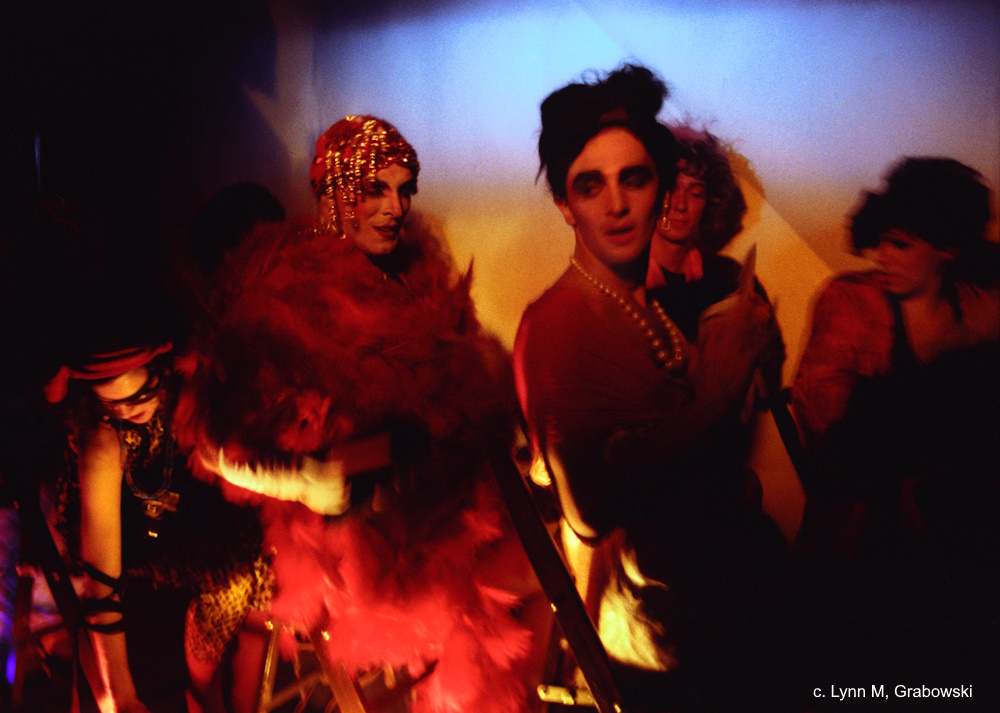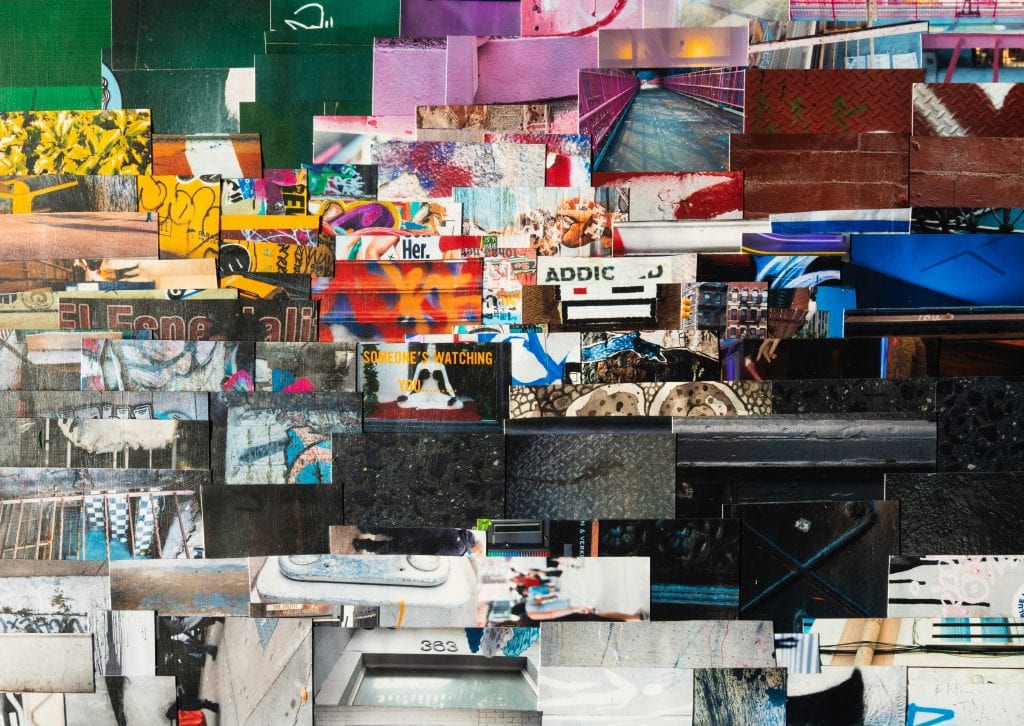What is the concept of this show?
My Father Was a Satyr is an autobiographical myth rooted in the universal theme of “the hero’s journey” and other archetypes of mythology described in the work of Joseph Campbell. This is the story of my life, beginning with a childhood steeped in art and nature, where my parents encouraged me to go after what I wanted in life, and to seek knowledge and experience. I left the nest for the Rotten Apple and fell in step with a culture I soon discovered to be in decline. During those beautiful decades in the Lower East Side, I grew as an artist and a person. As my new community continued to disintegrate, I eventually returned home to Connecticut, a place I’d once shunned and relished leaving. To my surprise, I now find myself falling in love with New England, while still keeping a diasporic foothold in the precarious mirage of New York City.
Why the mythic narrative?
The mythic narrative interests me because it conveys, preserves, and evolves what it is to be alive. Myth fits the present into the broader cycle of eternity, affirming the fundamental order of the universe. My intent is to personalize the way our own myths uplift and lend significance and purpose to a larger universal truth through the lens of individual stories.
What is the focal piece of the show?
The central painting of the show is titled The Threshold. The satyr, a mischievous woodland creature, divides the picture plane—between home depicted on the right and adventure on the left. He plays his flute along the river, beckoning us away from the safety and comfort of the ordinary world and into the realm of magic and possibilities…of hope, desire, fortune, and danger.
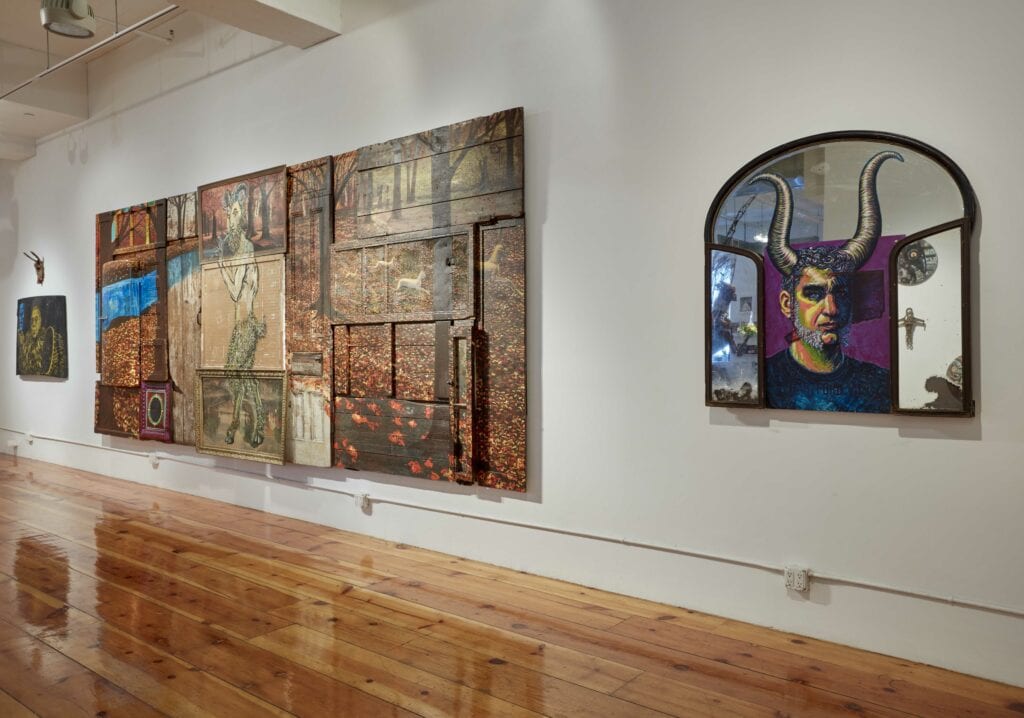
Does the satyr represent your father?
The satyr is not a literal rendering of my father, but in many ways does represent him. I was raised by an artist who related to the humor and mischief of Pan—more to the hidden, solitary, wild-animal qualities of the Roman faun than the lecherous, debauched character of the traditional Grecian satyr. But I chose the word ‘satyr’ over ‘faun,’ because there is no set series of traits specifically attributed to either. And ‘satyr’ is just a beautiful word.
How does The Threshold relate to the painting titled Home?
Home is a storybook lullaby depicting the nocturnal dreamscape of childhood and the memories of home. My childhood cat, Bosco, stands in this painting as a gentle and powerful deity of the homestead, holding the space of spirit and memory. In the landscape behind him is the family home, a Tuscan-style stone farmhouse designed and built by my father. The arc illustrated across this series begins and ends in this home where I was raised, moved away from, and eventually returned to. And it is the place from which I hope to leave this world. It is the central vortex of ‘place’ to which I belong.
So we’ve crossed the threshold from the ordinary world, away from home, into one of exploration and adventure. Where does this take us next?
For me, the battleground of self-discovery was New York City, and the front line was the Mars Bar. The Shaman is my portrait of Hank Penza, the legendary owner of bars on the Bowery since 1957. He was the proprietor of the Mars Bar—the last true Bowery bar. The goatskin coat and ceremonial mask and bells Hank wears here are borrowed from the pre-Christian rituals of Mamoiada, Sardinia. They belong to the Mamuthones, characters said to represent the inhabitants of the kingdom of the dead.
Mars Bar was a sort of portal into hell where one could easily enter but many did not leave. It was a hard-drinkin’, hard-druggin’, occasionally violent, often depressing, always unpredictable vortex of madness and excess. Through its doors, every ‘Martian’ was either purified or destroyed. Many dear souls didn’t survive. In my portrait, Hank stands in the role of the shaman—a quasi-mortal guide at the gates of hell. He is the patron of the brave, of lost souls, and of the helpless. After my father’s passing, Hank had become a sort of paternal figure to me in a real down-and-dirty, Lower East Side way. Hank sat every weekday outside, on the sidewalk; or inside the corner of his smelly little dive bar; and held court like the mayor of the neighborhood. He knew everybody and was either loved or feared…but always respected by everyone who passed by. Very few did not know who he was. Hank passed away shortly after the Mars Bar was shuttered—a block away from his beloved corner—with a smile on his face.
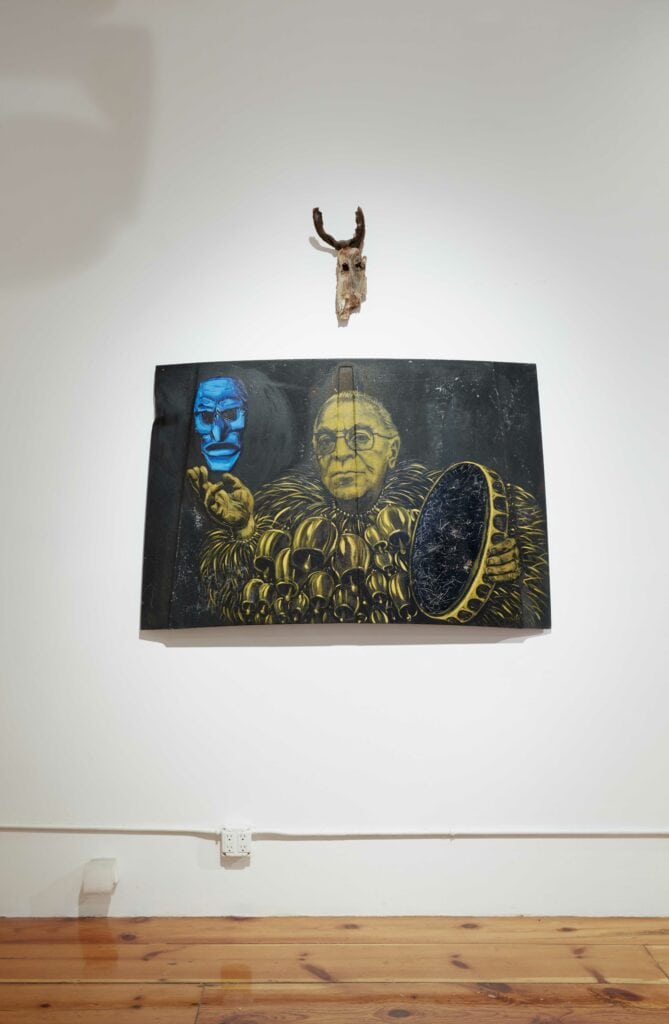
New York City has an incredible power to forge through trial of fire. What was central to the evolution you experienced in the city?
During my decades in New York I dealt with many challenges and losses. At one point three of my closest male friends died—my father and my two best friends. During this time, I had a dream of a fearsome creature that had come into my house to destroy me. It came right up to me with its razor-sharp teeth glistening an inch from my face. Initially paralyzed with fear, I quickly sensed that this beast was not here to harm me, but to challenge and protect me. Life has always supplied me with allies, mentors, and guides that have helped me emerge from the underworld of fear cleansed and transformed.
The body of this piece is a found object, a former public sculpture from the city of Hartford, where it was destroyed during riots in the 1960s. It recalls a time of fear, revolt, and reckoning. Fear represents the heart of the journey, the central life-or-death crisis that pushes each of us to grow to our full potential or crumble to ashes.
So if you are lucky, you emerge transformed. Is this where the snake comes in?
Yes. The snake painting, named after a Leonard Cohen song, “New Skin for the Old Ceremony”, reflects the act of metamorphosis, healing, and rebirth. Once I had left home to find my way in the world, I came up against adversity and—as everyone who risks a leap into the unknown—I endured true loss. But I have found a way to turn my lead into gold. Those alchemical moments can cause endless layers of ego to be shed and, like the molting snake, I have emerged from my old skin with a new, deeper understanding of who I am and how I fit into the bizarre experiment of life.
How is this deeper understanding reflected in the show?
The sculpture of the gryphon entitled The Elixir of Life depicts the victor of the ultimate battle, emerging from the flames with the supreme panacea in its talons. I think what ultimately surfaces through transformation is the true desire for self-discovery. For me, some of the most difficult and revealing moments of my life were experienced during ayahuasca ceremonies where I learned that my time here in this physical realm is precious—that it is up to me to really go after what I want, breaking through fear with unrelenting intention and deliberate action. In the wake of those sacred rituals, I emerged more connected to the everyday magic of life.
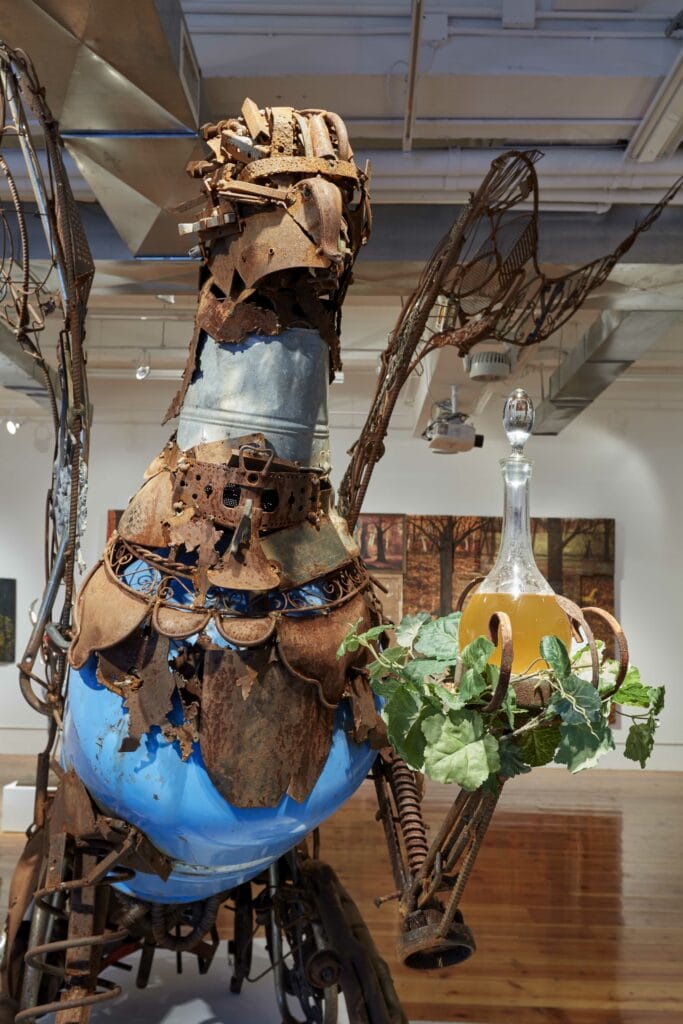
Is the man with the horns and sideburns a self-portrait of a transformed and wiser soul?
Mid-Century Satyr is a self-portrait as a 50-year-old man who has finally earned his horns. Who knew it would take so long? It’s painted on the mud flap of a big rig with the name of the city where my father was born, Hartford, emblazoned across my chest. This rugged bit of blue-collar refuse reflects the work ethic of my upbringing. A map of Connecticut—the state I once shunned but have since grown to love—cuts across my face, lending a shadowy background to the piece. In the tradition of my father, I’ve returned home to the woods of New England and stepped into his role as a magical woodland creature. I have earned a place back in the ordinary, cultivating the legacy that was so lovingly passed on to me, with a fresh perspective full of endless possibilities.
The figures of the Madonna & Child also seem to be magical woodland creatures. What is the quasi-musical object that this piece is painted on, and how does it tie in to the rest of the show?
Madonna & Child is painted on a true work of folk art created by Eddie Boros, a late neighbor from the East Village and a real LES character, whose claim to fame was the tower he built in the 6 & B Garden. It was a monumental wooden structure, laden with rocking horses, Frankenstein heads, and toys of all stripes. Eddie also built unrideable bicycles and unplayable instruments, like this one. When he died in 2007, the contents of his apartment were thrown into a container outside his window. I was passing by when I saw this incredible monstrosity cresting the horizon of a dumpster. I grabbed it immediately, disappointed to see it had been punctured when it was so carelessly discarded. It lived with me for over a decade before finding its way to my easel. Another musical instrument, it is a reprise to the satyr, and a window into the adventure and self-discovery of generations to come. Family and children continue to carry the narrative forward as the patterns of myth repeat into the future.


